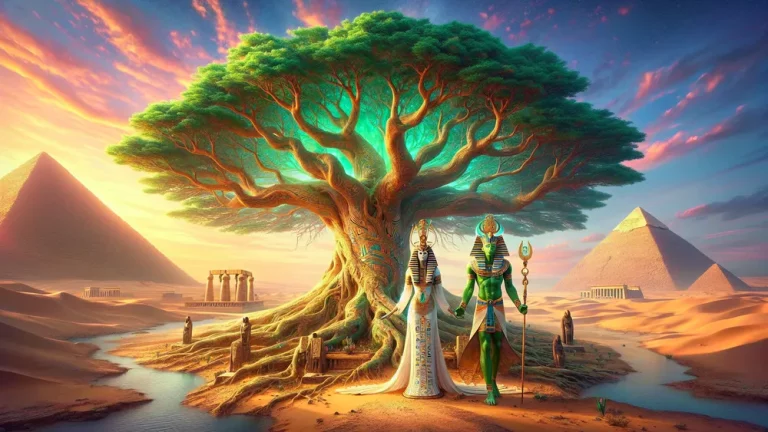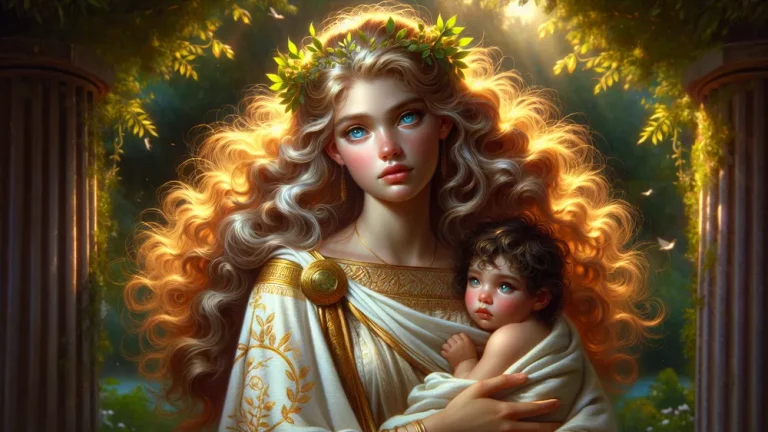Iris: Greek Goddess Of The Rainbow And Divine Messenger
You probably think of names like Zeus, Hera, and Athena when you hear about Greek mythology. However, the group of gods of Greek mythology is really big and it has a lot of interesting characters, each having their own special roles and stories. A character you might not know about is Iris, who is the goddess of the rainbow and also a divine messenger.
Key Points:
- Iris is the Greek goddess of the rainbow and a divine messenger.
- Born to Thaumas, a sea god, and Electra, an Oceanid, Iris has sisters known as the Harpies.
- She’s often seen in Homer’s Iliad and Hesiod’s Theogony, delivering messages for gods like Zeus and Hera.
- Iris is often pictured with golden wings for swift travels and a caduceus, signifying her role as a divine messenger.
- Iris played a vital role in the Trojan War, communicating divine messages to both sides of the battle.
- She appears in various forms of art and literature, from ancient Greek vase paintings to modern retellings like Percy Jackson and the Olympians.
- Although she didn’t have as many temples as other gods, Iris was worshipped at certain sites and during colorful festivals.
Picture Iris like an old-school postal service, bringing messages between gods and humans with a quick and colorful rainbow. In this blog post, we will talk about who Iris is, her important roles in mythology, and the different symbols linked to her.
Whether Greek mythology is new to you or you’re aiming to get better at it, this detailed guide will explain many parts of Iris, from her family background to how she appears in art and writing.
Iris: Overview and Key Facts
| Key Point | Description |
|---|---|
| Name | Iris |
| Role | Greek Goddess of the Rainbow and Divine Messenger |
| Parents | Thaumas (a sea god) and Electra (an Oceanid) |
| Siblings | Harpies (Aello, Ocypete, and Celaeno) |
| Signs | Rainbow, Caduceus (herald’s staff), Golden Wings |
| Main Jobs | Carrying messages for gods like Zeus and Hera |
| Importance in Culture | Means the connection between gods and people |
| Appearances in Stories | Seen in Homer’s Iliad and Hesiod’s Theogony |
| Linked Myths | Role in the Trojan War, Connection with the Harpies |
| Worship | Temples and rituals for her, though not as significant as big gods |
| Festivals | Specific events and celebrations for her |
Where Iris Comes From
To grasp Iris’ importance in Greek mythology, it is important to look into where she comes from and her family ties. Let us dig into her origins as well as her family’s story.
Her Birth and Family Tree
Iris was born to Thaumas, a sea god known for his amazing traits, and Electra, one of the Oceanids, who were the many daughters of the Titans Oceanus and Tethys. Consider Thaumas and Electra like a powerful couple from ancient times, mixing the mysteries of the sea with the caring side of freshwater. Iris’ brothers and sisters are the Harpies – Aello, Ocypete, and Celaeno.
Often described as wind spirits with the bodies of birds and the faces of women, the Harpies had jobs as agents of punishment for the gods, catching people and things when the gods demanded it. This gives Iris’ family a lot of variety with each member having their own special jobs in Greek mythology.

Iris comes from a diverse family with her parents blending sea and freshwater traits, and her siblings being Harpies who served as agents of punishment for the gods, offering a unique mix of roles in Greek mythology.
Iris in Old Stories
Iris is seen a lot in ancient Greek stories, being a godly messenger in some of the important writings. In Homer’s Iliad, Iris is described as a swift and reliable messenger for the gods, especially Zeus and Hera. For example, in Book 2, Zeus sends Iris to give a message to the Trojan prince Hector, telling him to get ready for battle.
This part shows Iris’ job as a crucial go-between who makes sure the gods’ wishes are told to people. Consider her like a messenger who quickly gives the latest news from the gods to the humans. Her being in the Iliad shows how communication between gods and people was important in Greek stories.
In Hesiod’s Theogony, Iris is mentioned as part of the family tree of the gods, pointing out her divine background and connections. The Theogony says she is the daughter of Thaumas and Electra, linking her to the larger group of sea gods and Oceanids. This story provides a basic understanding of Iris’ place among the gods, showing her origins and family ties.
By having Iris in the family tree, Hesiod not only points out her job as a messenger but also shows her place in the complicated web of relationships that Greek mythology is known for. This family context helps readers see how connected the gods are and their different areas.
Iris’ Job and Meaning
After looking at Iris’ beginnings and her appearances in old stories, let’s look closely at what she does and the important meanings linked to her.
Messenger for the Gods
Iris was the godly messenger for the gods, especially for Zeus, the king, and Hera, the queen. Think of her like an ancient mail carrier, tasked with bringing important messages between the worlds of gods and humans. Her job was to make sure the gods’ commands and wishes were given correctly and quickly.
For example, when Zeus needed to give a message to a human hero or another god, Iris would travel super-fast, often described with golden wings, to deliver the message. This made her a key link between the divine and human worlds, helping communication and making sure the gods’ wishes were known and done.
The Rainbow’s Meaning
In Greek myths, the rainbow has deep meaning, mainly linked to Iris, who represents this thing. The rainbow is often seen as a link between the sky and the ground, which means a connection between the gods and people. Like how a rainbow looks after a storm, bringing peace and beauty, Iris’ job as a messenger brings understanding and talk between the gods and humans.
This idea of the rainbow as a link shows Iris’ role in bringing godly messages, making her a key connector for the will of the gods. The cultural and religious meaning of rainbows in old Greece goes beyond their look. Rainbows were thought to be signs from the gods, often seen as messages of hope or warnings.
In religious settings, seeing a rainbow could mean godly approval or a reminder of the gods’ power. For the old Greeks, who respected natural things as signs of gods’ will, the rainbow was a strong symbol of connection and communication. Iris, the goddess of the rainbow, meant this link, always reminding people of the gods’ power over the natural world and their constant interaction with humans.
Iris’ Traits and Symbols
Iris is often seen with several unique traits and symbols that show off her role and importance in Greek myths. This means things like:
- Golden Wings: People often see Iris with golden wings. These wings, like modern fast delivery methods, mean messages get there fast between the worlds of gods and humans. She can travel quickly.
- Caduceus: Sometimes she has a caduceus, a staff with two snakes around it, which is also tied to Hermes. This means her role as a messenger and her right to talk for the gods.
- Rainbow: Being the person who stands for the rainbow, Iris herself is a symbol of connection and talk, linking the sky and the ground.
- Water Pitcher: In some pictures, Iris carries a water pitcher, which means her job in giving water to the clouds and her link to the sea because of her parents.
Each of these symbols shows different parts of Iris’ work and why she is important in the group of Greek gods, making her a many-sided and essential god in old stories.
Iris is known for her unique symbols like golden wings, a caduceus, a rainbow, and a water pitcher that represent her role and significance in Greek mythology, portraying her as a versatile and vital deity with various responsibilities.
Stories and Legends About Iris
After looking at Iris’ roles, meanings, and symbols, let’s now go into the interesting stories and legends that include this interesting goddess.
Her Part in the Trojan War
In the Trojan War, Iris had a critical job as the godly messenger, bringing crucial messages from the gods to both the Greek and Trojan sides. Consider her like a war reporter, moving quickly between battle lines to give important information. One key thing she did was tell King Priam about his son Hector’s death, which had a lot of emotional impact and effects on strategy.

Also, Zeus sent Iris to tell the Trojan hero Aeneas to join the fight, making sure the gods’ will happened in battle. Her presence was a constant sign of the divine influence over the war’s events. Key moments where Iris’ work made a big difference include her step-in during the fight between Achilles and Agamemnon.
Hera sent Iris, and she urged Achilles to call a meeting to deal with Apollo’s plague, which was hitting the Greeks hard. This move was crucial in changing the direction of the fight and fixing the problems harming the unity of the Greek camp. Another big moment was when Iris gave Zeus’ order to Poseidon to leave the battlefield, changing the war’s dynamics.
Through these actions, Iris’ role as a divine messenger was key in shaping the story and results of the Trojan War.
Iris and the Harpies
In Greek myths, Iris is linked to the Harpies, who are her sisters. The Harpies, often shown as wind spirits with bodies of birds and faces of women, are known for being swift and sometimes destructive, like stormy weather. Iris, with her golden wings and role as a godly messenger, means a more calming and orderly presence.

This family link shows the two sides of the natural world – both wild and harmonious. The story of Iris and the Harpies highlights the balance between these forces, with Iris often acting like a peacemaker who can calm her sisters’ wild nature.
This relationship is important in Greek myths because it shows how different godly beings are connected and their impact on natural events.
Iris in Art and Books
People have been interested in Iris in many works of art and literature throughout history. Notable examples include ancient Greek vase paintings where she is often shown with her golden wings and caduceus, meaning her role as a godly messenger. In writing, Iris appears in Homer’s “Iliad,” where she is called a swift-footed messenger of the gods, and in Hesiod’s “Theogony,” which tells her family and duties.
These stories and artworks give us a detailed look at her character, meaning her importance among the Greek deities. Think of these old ways she’s shown like key scenes in movies that explain a character’s role and significance.

Besides old texts, Iris has also appeared in more recent works. For example, in the Renaissance period, artists like Raphael painted Iris, often showing her with a rainbow to mean her link to rainbows. In modern literature, Iris appears in many retellings of Greek myths, such as Rick Riordan’s “Percy Jackson and the Olympians” series, where she is reworked for today’s readers. These ways she’s shown not only highlight her lasting presence but also update her image to fit the cultural and historical context of the time. Here are some notable works featuring Iris:
- Homer’s “Iliad”
- Hesiod’s “Theogony”
- Ancient Greek vase paintings
- Raphael’s Renaissance paintings
- Rick Riordan’s “Percy Jackson and the Olympians” series
Each of these works adds to the rich and varied ways she’s shown, reflecting her multifaceted role in mythology and her lasting impact on art and books.
Worship and Followers of Iris
After we looked at how Iris is shown in art and books, we now look at how people worshipped and honored her in ancient Greece.
Temples and Holy Places
In ancient Greece, even though Iris didn’t have as many set up temples as some of the well-known gods and goddesses, there were still holy places and altars where she was respected. These sites were often near bodies of water, which meant her link to the rainbow and the sky. For instance, small shrines for Iris could be found near rivers and springs, where people who prayed would leave offerings like flowers and incense.

People did rituals for her that usually included prayers for clear communication and quick trips, kind of like praying for safe journeys today. These ceremonies often had the burning of aromatic herbs and the pouring of libations, meaning the path of messages between the divine and mortal worlds.
Festivals and Parties
Iris didn’t have as many festivals as other gods, but they did exist, and people celebrated them with great enthusiasm in some areas. Often, these festivals happened when natural events like rainbows appear, meaning Iris’ link to the sky and weather. An example was the “Irisia,” a festival with colorful parades and flower offerings to honor her. People dressed in vibrant clothing to look like the colors of the rainbow, almost like how people today might dress up for a theme event. Traditional customs included the saying of hymns and the performance of dances that meant the swift movement of Iris as a messenger. Here are some notable festivals dedicated to Iris:

- Irisia: A festival featuring colorful parades and flower offerings.
- Rainbow Celebrations: Events held during the appearance of rainbows, involving hymns and dances.
- Seasonal Rites: Ceremonies marking the change of seasons, invoking Iris for favorable weather and communication.
These customs and traditions not only honored Iris but also strengthened her role as a link between the divine and mortal worlds.
Iris had fewer festivals compared to other gods, but those that did occur were celebrated enthusiastically, especially when rainbows appeared, symbolizing her connection to the sky and weather, like the Irisia festival, where people dressed in rainbow colors and performed dances to mimic Iris’ swift movements.
Pantheon of Greek Mythology
Greek mythology includes a huge, complex family of gods and goddesses, each with their own roles and stories. From powerful Zeus, the king of gods, to smart Athena, the goddess of wisdom, the pantheon includes many gods who controlled different parts of life and nature. To find a complete list of all the Greek Gods, you can delve into the intricate relationships and fascinating tales that make up these full myth stories.
FAQs
1. Who were Iris’ parents in Greek mythology?
Iris’ parents in Greek mythology were Thaumas and Electra.
2. What role did Iris play in the Trojan War?
The role Iris played in the Trojan War involved acting as a divine messenger, delivering crucial messages from the gods to both mortals and other deities.
3. What are the symbols associated with Iris?
The symbols associated with Iris include the caduceus and golden wings, which signify her role as a divine messenger.
4. How was Iris worshipped in ancient Greece?
How Iris was worshipped in ancient Greece involved rituals and ceremonies dedicated to her at various temples and sanctuaries.







